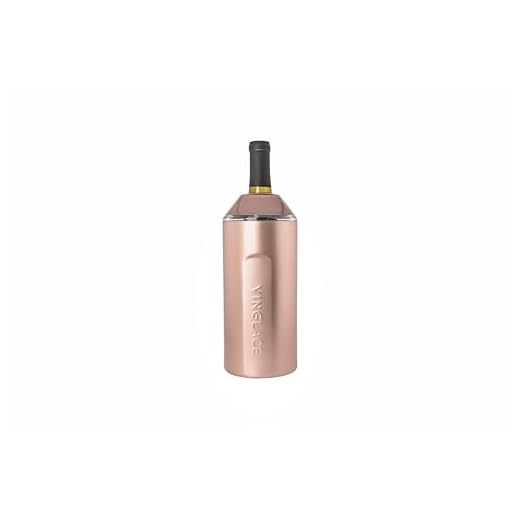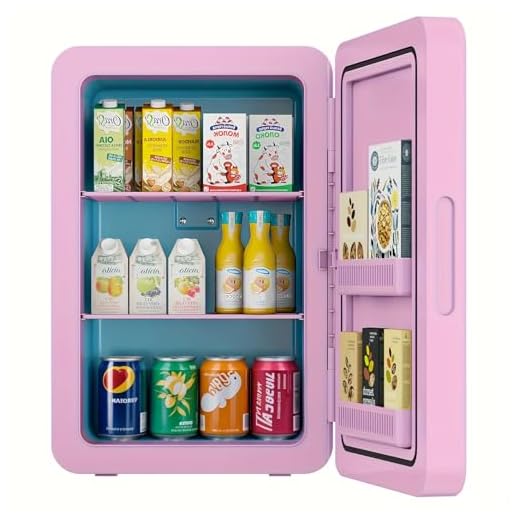

Serving this delightful pink beverage at the right temperature enhances its character and complexity. Ideally, aim for a range between 45°F to 55°F (7°C to 13°C). This coolness preserves the refreshing qualities while allowing the nuanced flavors to shine.
To achieve this ideal state, place the bottle in a bucket filled with ice and water for about 20 minutes. Alternatively, refrigerate it for approximately 2 to 3 hours before serving. Avoid the common mistake of serving it too cold, as overly chilled options can mask the subtle aromas that make each sip enjoyable.
Experiment with various types to discover how temperature influences their profiles. Lighter, fruit-forward varieties benefit from being on the cooler side, while those with richer flavors can be served slightly warmer. This attention to detail in serving will elevate your experience and impress your guests.
Chilling Recommendations for Pink Libations
I recommend serving pink libations at a temperature between 45°F to 55°F (7°C to 13°C). This range enhances the delicate aromas and refreshing qualities, allowing the nuanced flavors to shine.
For optimal enjoyment, consider the following tips:
- Refrigerate the bottle for approximately 2-3 hours before serving. This approach ensures a balanced temperature without losing the essence of the drink.
- If you’re short on time, an ice bucket filled with equal parts ice and water can cool the bottle in about 20-30 minutes.
- Be mindful of the type of pink beverage; lighter styles generally benefit from cooler temperatures, while richer varieties may be better slightly warmer.
It’s worth experimenting with temperatures to find your preferred balance. Each bottle can present unique characteristics, and slight variations in serving temperature can significantly impact your tasting experience.
Enjoying these delightful drinks at the right temperature can elevate your gatherings and meals, making every sip memorable.
Understanding the Ideal Serving Temperature for Rosé Wine
The optimal serving temperature for a chilled pink beverage is between 45°F to 55°F (7°C to 13°C). This range allows the nuanced flavors to shine, enhancing the overall tasting experience. If served too cold, the complexity can be masked, while a warmer temperature may bring out undesirable characteristics.
Temperature Guidelines
For best results, store the bottles in a refrigerator for a couple of hours prior to serving. Alternatively, an ice bucket filled with a mix of ice and water can quickly lower the temperature. Aim for a serving temperature closer to 50°F (10°C) for most varieties, especially those with more fruit-forward profiles. Lighter styles can be enjoyed at the lower end of the scale.
Impact on Flavor Profile
Temperature influences the perception of acidity and sweetness. As the beverage warms, sweetness can become more pronounced, while acidity might wane. Finding the right balance is key to enjoying the full spectrum of flavors. Always taste at different temperatures to discover your personal preference. Remember, the aim is to highlight the delightful characteristics unique to each bottle.
How Chilling Affects the Flavor Profile of Rosé
Serving this delightful beverage at the appropriate temperature significantly enhances its flavor profile. Aiming for a range between 45°F and 55°F (7°C to 13°C) typically brings out the best characteristics. Below are some key effects of temperature on taste:
- Fruity Notes: Cooler temperatures tend to emphasize fresh, fruity aromas like strawberries and raspberries. This can elevate the perception of sweetness without the actual sugar content being high.
- Acidity: A lower temperature can accentuate the crispness and acidity, creating a refreshing finish. This is particularly desirable in warm weather.
- Body and Texture: As the temperature rises, the fuller mouthfeel becomes more pronounced. This can result in a richer experience, highlighting notes of creaminess or minerality.
- Aroma Release: Warmer temperatures can enhance aromatic complexity. However, too much warmth may lead to the loss of delicate floral scents, which are often a hallmark of quality selections.
To achieve a balanced experience, it’s advisable to monitor the temperature closely. If the selection warms up too much in the glass, it may mask the delightful nuances that make it enjoyable. When pairing with food, consider how temperature impacts both the beverage and the dish to create a harmonious combination.
Best Methods for Chilling Rose Wine Quickly
For a swift drop in temperature, the ice and water method works wonders. Fill a bucket halfway with ice, then add cold water until it reaches about three-quarters full. Submerge the bottle in this mixture, ensuring it is surrounded by both ice and water. Within 15 minutes, you’ll have a perfectly cooled beverage ready to enjoy.
Salt for Speed
Incorporating salt into the ice and water mixture accelerates the cooling process. Just a handful of salt will lower the freezing point of the water, allowing the temperature to drop faster. Expect your selected bottle to reach an optimal temperature in about 10-12 minutes.
Freezer Method
If you’re in a pinch, placing the bottle in the freezer can be effective. Wrap the bottle in a damp cloth before putting it in the freezer. This cloth will help conduct the cold and enhance the chilling process. Set a timer for no longer than 30 minutes to avoid freezing and damaging the contents.
Common Mistakes When Chilling Rosé
Avoid the pitfall of using the freezer for a quick cool down. Instead of achieving the desired temperature, it often leads to a frozen bottle, compromising flavor and texture.
Another frequent error is neglecting to account for the temperature of the glass. Pouring a chilled beverage into a warm glass can quickly raise its temperature, diminishing the refreshing experience.
Using ice cubes directly in the glass can dilute the drink and alter its intended flavor profile. Instead, consider using ice in a separate bucket to keep the bottle cool without impacting the taste.
Moreover, overlooking the serving temperature can result in a less enjoyable experience. Aiming for a range of 45°F to 55°F ensures that the nuanced flavors remain intact and vibrant.
Lastly, not allowing the bottle to rest after removing it from the cooling method can lead to a temperature shock. Let it stabilize for a short period before pouring to ensure optimal enjoyment.
Pairing Chilled Pink Beverage with Food: What You Need to Know
For optimal enjoyment, serve your chilled pink beverage alongside light dishes and seafood. The crisp acidity and fruit-forward profile enhance flavors in salads, grilled vegetables, and shellfish, creating a harmonious dining experience.
Recommended Food Pairings
Here are some excellent options to consider:
| Food | Pairing Notes |
|---|---|
| Grilled Shrimp | The brightness of the drink complements the charred flavors. |
| Caprese Salad | Fresh mozzarella and tomatoes highlight the beverage’s acidity. |
| Chicken Salad | Herbs and citrus notes in the dish enhance the fruity notes. |
| Spicy Asian Dishes | Coolness counteracts heat, creating a balanced palate. |
| Charcuterie Board | Delicious with cured meats and cheeses, offering diverse flavors. |
Serving Temperature Considerations
Ensure that the temperature of your chilled pink beverage is maintained throughout the meal. A slight increase in warmth can diminish its refreshing qualities, so keep it in an ice bucket or insulated cooler during service. This practice enhances food pairing enjoyment and maintains the drink’s crispness.
When to Skip Chilling: Situations for Serving Rosé at Room Temperature
For certain scenarios, serving this pink beverage at room temperature can enhance its characteristics. If the bottle is of higher quality or crafted with a focus on complexity, temperature elevation allows the nuanced aromas and flavors to fully express themselves. This is particularly true for those that have a richer profile, with pronounced fruit notes and a hint of oak.
Additionally, if you’re enjoying your drink in a cooler climate, serving it at ambient temperature can prevent it from feeling too cold and muted. In a warm environment, aromas can dissipate quickly, and a slightly warmer temperature helps in retaining these aromatic qualities, making every sip more enjoyable.
During food pairings, consider the dish. Hearty or spicy meals might be better complemented by a slightly warmer glass, allowing the flavors of both the food and the beverage to harmonize more effectively. For example, a robust grilled chicken or spicy seafood dish can benefit from this approach.
Lastly, if you’re in an informal setting where the ambiance is relaxed, serving this delightful drink at room temperature can create a more casual experience, allowing guests to savor the essence of the beverage without the distraction of extreme cold. For those who appreciate the art of wine, understanding these subtleties can elevate the overall tasting experience.
For more tips on maintaining your outdoor spaces, check out the best cleaner for washing windows with a pressure washer.








